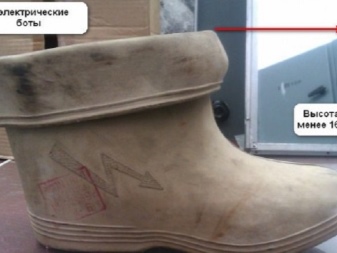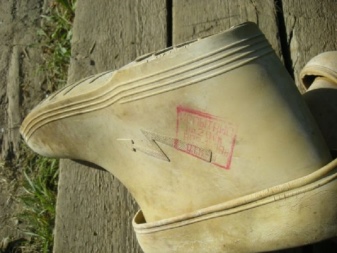What are dielectric bots and how often should they be tested?

Carrying out electrical work requires compliance with safety rules. Due to this, it is possible to avoid dangerous situations that can lead to serious injury to the employee, as well as death.
First of all, a person starting work at a hazardous facility must wear protective clothing and shoes. The latter includes dielectric bots, which will be discussed in this article.

What is it and in what electrical installations are they used?
Dielectric rubber boots are safety shoes that do not allow electric current to pass through, regardless of the type of its impact. Their main purpose is to ensure the protection of a person from electrical stress.
The use of overalls and safety footwear is a necessary measure to avoid the negative effects of voltage on electrical installations.
The use of a dielectric bot will effectively prevent the operator from stepping voltage that develops between adjacent points on the earth's surface.

The length of this tension is one human step.
Dielectric shoes are in demand in electrical installations where work with high voltage takes place.... Indicators reach 1000-2000 volts... Each personal protective equipment is accompanied by certificates of compliance with GOST or standards, and also has special characteristics.


How do they differ from galoshes?
There are two types of dielectric footwear:
- boots;
- galoshes.


Each of the listed types has its own characteristics and its own field of application. The former are distinguished by the presence of an upper flap, which prevents the penetration of the liquid into the interior. The shoes in question have a wide range of sizes, ranging from 292 cm to 352 cm.To determine the size, a special table is used.

The difference between galoshes is not only in their appearance, but also in height. They are used in areas where work takes place with a voltage of 1000 volts. Safety boots provide more safety, allowing you to work with voltages up to 2000 volts.

Species overview
Today manufacturers produce several types of dielectric bots. It is worth taking a closer look at each species.
Glued
They are rubber products that have an annular shape and are distinguished by a large number of layers. The composition of such shoes, according to the technical specification, includes:
- the upper part is made of rubber;
- sole with projections made of the same material;
- a backdrop made of twill;
- high density knitted fabric lining;
- internal elements to ensure durability.


The color of these shoes ranges from beige to light gray. Additionally, the bot has a lapel at the top.
It prevents liquid from entering the shoe. The height of the product does not exceed 16 cm, and the thickness of the sole is 0.6 cm or more.

Shaped
The production of such shoes involves the presence of blanks from a special rubber compound. Further blanks:
- collect;
- molded;
- vulcanize.
At the final stage, deburring and extrusion are removed to give the shoe a more attractive look and make it more reliable. Additionally, the product is finished.


It is noteworthy that the molded bot has no fastening and fixing elements, and there is also no textile lining. Lapels are provided.

Dimensions (edit)
Determination of the size of dielectric shoes is carried out according to a special table. It can be found in the regulations and GOSTs, which also specify the requirements for the manufacture of bots.
State standards also indicate what the height of the boots and the width of the shin should be.


The size range of electrically resistant shoes looks like this:
- for women - 225–255;
- for men - 240–307.
They also produce universal bots. They are suitable for both men and women and are available in sizes 292–352. The internal size of the product is not regulated by the norms, since it must match the external one. Therefore, when testing shoes, it is not tested.

Features of storage and operation
Storing safety footwear is a process that needs to be approached responsibly. In order to ensure the long life of dielectric bots and not compromise their protective properties, several conditions must be taken into account.
- You need to store your shoes in a dark and closed roomwhere animals or children cannot get.
- The room temperature should be within 0 to 20 degrees Celsius. Exceeding the indicator or lowering the temperature will lead to a decrease in the quality of rubber products.
- The warehouse should have racks or wooden shelves on which to put shoes... It is not recommended to store bots on the floor.
- Room humidity should be 50–70%.
- Do not store shoes near heating units... This can lead to a decrease in the quality of the material. The best option would be to place safety shoes at a distance of 1 m or more from the heating system.
- It is not recommended to store bots in close proximity to chemically aggressive environments. Exposure to acids, alkalis and other chemically active liquids can lead to deterioration of the material and construction of the shoe as a whole, which will make it impossible to use it.


The operation of dielectric footwear requires compliance with a number of standards, which are indicated in the relevant documents.
Care must be taken to ensure that the shoes are safe and sound. It is important that it is not exposed to mechanical stress, and also not damaged by hard, cutting objects or chemicals.

During use, boots are worn over clean and pre-dried shoes to provide better protection. Also, the operation of safety footwear requires compliance with important rules.
- If there is step voltage in the room, It is recommended to lay a mat or rubber plate on the floor for reliable operation. This will protect the operator from exposure to high electrical currents.
- Before purchasing a bot, it is recommended to pay attention to the sole. It indicates the life of the product, as well as the conditions of use. Some bots can be used from -15 to +40 degrees, while others can be used from -50 to +80 degrees Celsius.
- Working with high voltage equipment requires the simultaneous use of personal protective equipment... Boots should be worn with gloves, socks and other protective clothing.
At the end of the working process, the boots are removed and left on the territory of the service electrical installation.

If the work was carried out in unfavorable conditions, shoes are cleaned of dirt and dried.
Test timing and frequency
The shelf life of rubber shoes is 12 months, in some cases this figure can increase to 16 months. Before using a bot, galoshes or boots, it is necessary to test the shoes for electrical conductivity.
The polymer bot should be checked 3 times every 12 months. In some cases, the check is required to be carried out 3 times in six months. It is also necessary to test the shoes before any work in the electrical installation.

The verification time is 1 minute, and the procedure itself is not complicated.
As for new bots, the electrical protective equipment that covers the shoes must be checked in any case. The check is able to demonstrate the compliance of indicators with those prescribed in state standards.
Testing is allowed to be carried out:
- in the laboratory;
- in a domestic environment.


The latter option involves testing the bot at a high-voltage stand. Protective footwear should be cleaned prior to testing and its surface should be inspected for visible damage.
The top of the bot that is being checked must remain dry, otherwise the results will be invalid. Testing is performed in a specific order.
- First of all they prepare special equipment. For testing, a test transformer is used, equipped with contacts connected to the tank.
- Water is collected in the container, and conductors and a milliammeter are also laid. The liquid is required to immerse the test specimens in it.
- Place the bots in the water. In this case, the water should be below the edges of the cuffs, not exceeding a distance of 45 mm. If the integrity of the galoshes is checked, then the indicator is reduced to 25 mm.
- A current is passed through the shoe, the value of which is 2–7.5 mA, depending on the type of the tested shoe. The test voltage in this case is in the range from 3.5 to 15 kV.

Subsequently, the condition of the shoe is analyzed. If the bots or galoshes pass the test, they are stamped. Otherwise, the shoes are marked with a red stamp and disposed of.
It is worth noting that testing rubber shoes is not always possible. Therefore, in order to prevent premature loss of protective properties, it is necessary to ensure the correct storage of safety shoes.
Verification is carried out not only in laboratories. You should also pay special attention to the visual inspection of the shoes.
- It is important that the shoes are intact during use, - no scratches, cracks, chipping or cuts are allowed. If such defects are found, the shoes are disposed of.
- Shoes must be cleaned before use... Dirt should not be present on the cuffs or on the outsole.
- After prolonged use of the bot, their lining begins to peel off.... If you find a similar problem, you should attach it back with glue or purchase new shoes.


Dielectric bots are designed for use in hazardous areas. Therefore, the choice of such products, their storage and operation should be treated responsibly.
An overview of the dielectric bot "Euroservice", see below.








The comment was sent successfully.